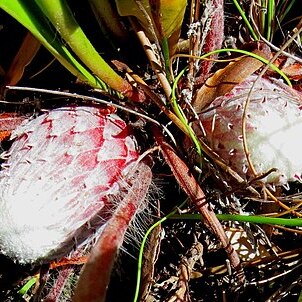A low, prostrate shrub, forming dense tufts, 0.5-1.5 m in diam. and to 0.5 m in height. Stems and branch system tightly interlocking, spreading horizontally over substratum. Leaves clustered at ends of flowering shoots, 20-45 cm long, glabrous at maturity; petiolate, petiole, 10-20 cm long, semiterete, carmine; lamina conduplicate, elliptic to broadly elliptic or oblanceolate, 4-8 cm wide, hard and coriaceous; apex subacute to obtuse, occasionally minutely mucronate; margins horny. Inflorescences terminal, sessile, broadly turbinate, later cyathiform, 8-12 cm in diam., 10-12 cm long, surrounded at base by loose, brown, papyraceous, lanceolate-acuminate involucral leaves, 2-3 cm long, 0.5-1 cm broad. Receptacle convex, 2.5-3.5 cm in diam. Involucral bracts 6-8 seriate, the innermost series very narrowly linear-lanceolate, acuminate, 4-4.5 cm long, 4-6 mm wide, inner surface glabrous and brilliant crimson, outer surface covered with a dense, white lanate indumentum; outer series ovate-acute, 2-3.5 cm long, 1.5-2 cm broad, outer surface glabrous and crimson at base, but covered with a very dense, white, lanate indumentum on upper part. Perianth 5.5-6.5 cm long, slightly adaxially curved; tube glabrous, quadrangular; claws glabrous on outer surface but inner surface and margins puberulous; limbs, 1.5-1.7 cm long, linear, thickly villous to lanate, apices acuminate. Anthers subsessile, 8 mm long, apical boss acuminate. Style slightly adaxially arcuate, 5.5-6 cm long, flattened longitudinally above ovary, tapering sub-terminally. Pollen presenter linear, acute, 1 cm long. Ovary narrowly obovoid, 5 mm long, covered with long, straight, white hairs. Hypogynous scales very broadly ovate, 1.5 mm long. The flowering season is brief but well defined, commencing in mid-January and continuing until the end of February.
More
Dwarf shrub, 0.4-0.5 m high, prostrate, branches creeping. Leaves petiolate, elliptic to oblanceolate, folded lengthwise, 200-450 x 40-80 mm, coriaceous, margins horny. Flower head deeply cup-shaped, 100-120 x 80-120 mm, with loose, brown lanceolate-acuminate basal bracts. Involucral bracts 6-8-seriate; outer series ovate-acute, 20-35 x 5-20 mm, outer surface glabrous, crimson at base, very dense, white, woolly indumentum on upper part; inner series linear-lanceolate, acuminate, 40-45 x 4-6 mm, inner surface glabrous, crimson, outer surface with dense, white, woolly indumentum. Flowers: perianth white, 55-65 mm long, slightly curved, tube 38-40 mm long, glabrous; style 55-60 mm long, white; pollen presenter 10 mm long, linear. Flowering time Jan., Feb.
Prostrate, mat-forming shrublet to 1.5 m diam. Leaves petiolate, oblanceolate, rough. Flower heads cup-shaped, 80-120 mm diam., involucral bracts acuminate, red, densely white-woolly outside, style 55-60 mm long.


